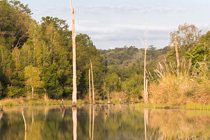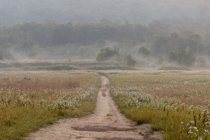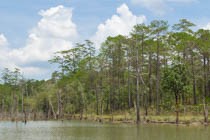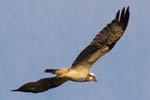Birdwatching Tours

Isan Explorer’s birdwatching tours visit Phu Khieo Wildlife Reserve and Nam Nao National Park, two of eight adjacent nature preserves at the northern end of the Phetchabun Mountain Range that comprise the Western Isaan Forest Complex, one of Thailand’s largest and least-disturbed forest regions. Both parks are Important Bird Areas (IBAs) and amongst the best birding destinations in Thailand, though they are rarely visited by foreign birdwatchers due to a mix of bureaucracy (we handle all of this) and remoteness. Almost every nature lover who does visit, however, raves about them.
Together they contain mostly mixed deciduous and dry evergreen forest, but the addition of many stands of pine trees offers a significantly different experience from most other spots birders visit on trips to Thailand. Both parks are flush with species that are difficult to tick anywhere else in Thailand thanks to exceptional visibility. And, despite having similar habitats and bird lists, each park has its own exciting signature species. It should also be noted that the birding is quite different from the well-known and often-visited Khao Yai National Park. Here is a bird checklist for the two parks.
This page contains general information about the parks and our birdwatching tours. The complete list of our birdwatching tours is at the bottom of this page. Note that if you prefer four legs to two we can switch the focus of these tours from birds to mammals.

Oriental Pied Hornbill 
Silver Pheasant 
Blue-winged Leafbird 
Oriental Darter
Phu Khieo Wildlife Reserve
Though Nam Nao is overall the better of the two parks for colorful forest birds, most of the same species are also present in the remote 1560 sq. kilometers (602 sq. miles) Phu Khieo Wildlife Reserve, which adjoins it to the south. Rarely visited, Phu Khieo (sometimes spelled Phu Khiao) covers a broad, tall plateau and offers a much greater wilderness vibe than Nam Nao. It has significantly more primary forest and the scattered grasslands and small lakes create a more varied birding experience.
The signature species is the endangered White-winged Duck, which can be found more reliably here than any other place in Thailand and odds are fairly high that you’ll be able to tick it off your life list. Other good possibilities at the lakes are Lesser Whistling-Duck, White-breasted Waterhen, Oriental Darter, Osprey, and Banded Kingfisher. Phu Khieo is also as good as anywhere in Thailand for both Austen’s Brown Hornbill and Coral-billed Ground Cuckoo, plus there are plenty of Great Hornbill, Siamese Fireback, and Silver Pheasant. Slender-billed Oriole, Brown Shirke, Savanna Nightjar, Eastern Stonechat, Common Kestral, Chestnut-headed Bee-eater, and Common Iora are found in and around the large Tung Kamang meadow.
Since this is a wildlife reserve, not a national park, the rules for visiting are rather restrictive. The permit process turns off some people, but we take care of everything so there is no hassle for you. Permits are supposed to be arranged at least 15 days before visiting, though if you want to book a tour with us on less time, we can usually manage it. The main caveat to a Phu Khieo tour is that the facilities are very basic, so if you need a certain level of comfort, Nam Nao is the better choice. See Lodging & Food below for full details or contact us if you want to discuss it.
Nam Nao National Park
Nam Nao National Park covers 966 sq. kilometers (373 sq. miles) across Phetchabun and Chaiyaphum provinces. The park’s name means “the water feels cold” and as one of the highest places in Isan, the temperature stays lower here (and at Phu Khieo too) than average. Most birders focus on the short trails branching out from the visitor center, and also in the open camping area surrounding the visitor center. In fact, you could possibly add a lifer while sitting down to a meal.
Nam Nao’s forest is prime habitat for woodpeckers (including Great Slaty, White-bellied, Greater Flameback, and Bamboo) and barbets (Blue-throated, Green-eared, and Moustached), but the main target of most birders is Silver Pheasant. Many interesting species, such as Scarlet Minivet, Orange Bellied Leafbird, Asian Fairy Bluebird, Vernal Hanging Parrot, Red-headed Trogon, Grey Treepie, Eurasian Jay, Collared Falconet, Oriental Pied Hornbill, and Bar-backed Partridge are quite easy to find here while Blue Pitta, Eared Pitta, Black Bulbul, Long-tailed Broadbill, Green Cochoa, Yellow-cheeked Tit, Slaty-backed Forktail, and Collared Owlet are less-common forest residents. A bit of grassland (Blue-breasted Quail, Great Eared Nightjar, Chinese Francolin, Yellow-eyed Babbler, and Brown Prinia) and a small impoundment (Blue-eared Kingfisher, Grey Heron, Osprey) on the southern side of the park provide a bit of variety.
Facilities are far better than at Phu Khieo (See Lodging & Food below) though Nam Nao gets far more visitors. Weekends and holidays, especially during the cool season, can be fairly busy; though there are never crowds even approaching the type found at famous national parks like Doi Inthanon, Khao Yai, and Khao Sok. And even on the busiest days few visitors walk the trails.
Mammals
Besides great birdwatching, the vast forest here hosts one of the healthiest populations of large mammals in Thailand and Phu Khieo in particular is one of the best wildlife watching areas in Thailand. Most noteworthy is that over 120 elephants live here and the chance of sightings in both Phu Khieo and Nam Nao is better than just about anywhere else in Thailand.
At Phu Khieo, sambar deer (Thailand’s largest), hog deer, and barking deer (aka red muntjac) are sure to be seen with many semi-tame ones regularly roaming around the visitor center. There are also lots of very vocal golden jackals around at night. White-handed gibbon and Phayre’s leaf monkey are two endangered primates that are often encountered, and Phu Khieo has the last healthy population of the latter in all of Thailand.
Deeper in the forest there’s a fair chance to find Asian palm civet, crab-eating mongoose, Indian giant flying squirrel, wild boar, dhole, lesser mouse deer, pig-tailed macaque, and porcupine while guar, southern serow, sun bear, Asian golden cat, binturong , pangolin, hog badger, yellow-throated marten, and slow loris are also out there, but much less likely to make an appearance. A few tigers, leopards, and clouded leopards are still hanging on, though there is virtually no chance of seeing them. One animal you definitely won’t see is Sumatran rhinoceros. The last confirmed evidence of them was in the late 1960s, though some websites continue to incorrectly write that they exist at Phu Khieo.
The same species call the forests of Nam Nao home too, though chances of meeting most are much lower.
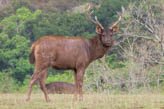
Sambar deer 
Elephant 
Phayre’s langur 
Golden jackal
Tour Style
Once we’ve arrived at the park there is no fixed schedule that must be followed and no long distances to cover, so at all times you can concentrate on seeking the species that you most want to find, and you can set the pace.
The places most people bird within both parks have no large hills so walking is generally easy. In Phu Khieo, we mostly walk on small roads while at Nam Nao we spend much of the time on forest footpaths. The altitude (800-900 meters; 2625-2950 feet) climbs high enough to cool the climate, but not enough to affect your breathing.
Our English-speaking tour guide will be with you at all times, but walks in the forest are led by local rangers, all of whom have years of experience at their particular parks. They’re not as polished as professional birding guides, but they are intimately familiar with the local species’ habits and habitats.
Birdwatching can be good year-round, but overall February to early March is the best time since the weather is cool and you have the possibility to see both winter and spring migrants. During this period, 100-plus species trips are possible. June to September are the rainiest months, but usually there is only rain for about an hour in the late afternoon. December and January can be downright cold with occasional frost. Read more about the climate (and also suggestions for what to pack) on our practicalities page. Note that it is possible to save money by visiting Nam Nao National Park by taking the bus there for your tour instead of a private driver, though this will greatly limit where you can go birding. Ask us about it if you are interested.
Lodging & Food
The bungalows at Nam Nao are modern and comfortable, albeit with plenty of wear and tear. Though far from fancy they’re definitely above average for Thai national park lodging. They have hot water showers, electric kettles, TVs, and 24-hour electricity. Beds are only singles. Two restaurants and some shops sell Thai and Isan food and basic supplies. Mobile phone reception is widely available and you can connect to wi-fi at the visitor center.
Facilities at Phu Khieo are much more basic. The main lodging is in old wooden rooms, many with shared squat-toilet bathrooms and thin mats on the floor instead of beds, while all rooms have cold-water showers and electricity only from dark until 9pm. You can use mobile phones, connect to wi-fi, and charge batteries during the day in the office. We usually have access to some slightly better rooms (at an additional cost of 300B per room), but these can’t be reserved until our arrival in the park so we can’t guarantee them. Some people prefer to camp at Phu Khieo rather than use the guestrooms, and gear can be hired, though we recommend bringing your own. The food here is delicious, though there is only one set menu available for each meal.
Khon Kaen city, where most guests stay before and after their tours, has a full array of modern and comfortable hotels and resorts. We can make recommendations and/or bookings if you want.

Nam Nao National Park 
Phu Khieo Wildlife Reserve
Birdwatching Tour List
Thanks to Khun Biak for the elephant photo. All other birdwatching tour photos were taken by the Isan Explorer team in Nam Nao National Park and Phu Khieo Wildlife Reserve. For the record, the White-winged Duck photo is a captive bird – we’ve seen them in the wild, but never got a good photo.













